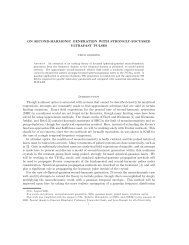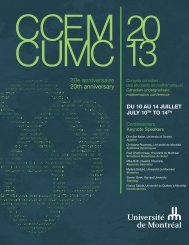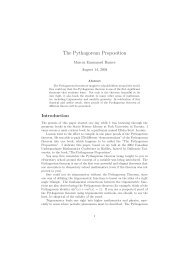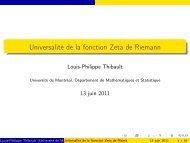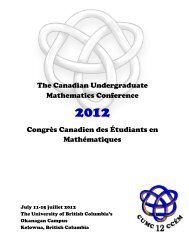Neuron Networks and Fourier Series - CUMC
Neuron Networks and Fourier Series - CUMC
Neuron Networks and Fourier Series - CUMC
You also want an ePaper? Increase the reach of your titles
YUMPU automatically turns print PDFs into web optimized ePapers that Google loves.
<strong>Neuron</strong> <strong>Networks</strong> <strong>and</strong> <strong>Fourier</strong> <strong>Series</strong><br />
Gene Foxwell, Carleton University, gene.foxwell@gmail.com<br />
July 30 2004<br />
1 Abstract<br />
In this paper we will give a brief abstraction of the idea of Artificial <strong>Neuron</strong><br />
<strong>Networks</strong> (ANN). Once this is done we will show how to generate the <strong>Fourier</strong><br />
Sine <strong>Series</strong> for curve which fits a set of given data points using an ANN. Finally,<br />
we shall end this paper with a proof that the <strong>Fourier</strong> Sine <strong>Series</strong> of any continous<br />
function can be approxomated by an ANN combined with the method shown.<br />
2 Artificial <strong>Neuron</strong>s<br />
In order to justify the abstraction used, we shall begin by examining a few<br />
important properties of Human <strong>Neuron</strong>s [1].<br />
Useful Properties of Human <strong>Neuron</strong>s<br />
1. <strong>Neuron</strong>s communicate thru excitory <strong>and</strong> inhibitory connections (or synapses)<br />
2. These synapses can be electrical or chemical. The chemical synapses are<br />
known to release Neurotransmitters which can change the properties of<br />
the synapse. i.e. make it more or less receptive to electrical stimulus.<br />
3. These signals are combined at the soma, changing the electrical properties<br />
of the <strong>Neuron</strong>(at rest the neuron has an electic potential created by<br />
pumping ions in <strong>and</strong> out thru the cell membrane) <strong>and</strong> are used by the cell<br />
to determine whether to send a signal out down to the dendrites.<br />
We can use the above facts above <strong>Neuron</strong>s can be used to create an abstract<br />
structure which has shown to be useful for many computational <strong>and</strong> theoretical<br />
purposes. Our abstraction shall be as follows:<br />
Abstraction of the Human <strong>Neuron</strong><br />
1
1. To each connection we assign a value w i ɛ R (which we shall refer to as the<br />
weight), where w i will represent how the i’th incomming synapse changes<br />
it’s input. So if x ɛ R is the input to the i’th connection, the synapse will<br />
change this signal to w i x.<br />
2. We then combine these signals using a simple summation. Thus, if ⃗x ɛ<br />
R n is the collection of inputs to a <strong>Neuron</strong>, <strong>and</strong> ⃗w ɛ R n is the collection<br />
of weights then we define the following to represent this property of the<br />
<strong>Neuron</strong> :<br />
s(⃗x) = ⃗x · ⃗w (1)<br />
3. We represent how the neuron responds to it’s signal by a function f :<br />
R → R Putting the properties we have so far together, we can represent<br />
a <strong>Neuron</strong> mathematically by a function N : R n → R which we define<br />
below:<br />
N(⃗x) = f(s(⃗x)) (2)<br />
Definition Throughout the remainder of this paper, by Artificial <strong>Neuron</strong> Network<br />
(ANN) we shall mean a directed graph G whose vertices shall represent<br />
abstract <strong>Neuron</strong>s as described above <strong>and</strong> whose edges shall represent the direction<br />
in which a signal is passed from one vertex to another.<br />
Definition The input layer of an ANN is the collection of <strong>Neuron</strong>s which can<br />
obtain a signal from a source outside of the ANN. i.e. they recieve input from<br />
the user.<br />
Definition The output layer of an ANN is the collection of <strong>Neuron</strong>s which are<br />
considered as part of the final result of the ANN. For example if the ANN was<br />
designed to predict the future direction of a fly, the output layer would the set<br />
of <strong>Neuron</strong>s which represented the final components of that direction.<br />
All ANN’s in this paper will be assumed to have no loops. Hence they can<br />
evaluated by simply evaluating the input layers first <strong>and</strong> propagating the signal<br />
from the input layer according to the structure of the graph until the output<br />
layer is reached.<br />
3 Representing Functions<br />
Consider the problem of scientist who has collected a sample set of data. Furthermore,<br />
let us suppose that the data was collected in such a way that the<br />
scientist would like to have an anaylitic curve which fits the data points. As<br />
with any measurement, the scientist can only be sure of the value of the point<br />
within some error tolerance ε. i.e. we would like a C 1 function such that for<br />
2
each of our data points (x ∗ , y ∗ ) we have ‖q(x ∗ )−y ∗ ‖ < ε for some predetermined<br />
ε. We shall show that an ANN can be used to solve this problem.<br />
To do this, we shall begin by considering a few methods via which the function<br />
would traditionaly be represented.<br />
1. Taylor <strong>Series</strong>:<br />
q(x) =<br />
∞∑<br />
n=1<br />
q (n) (x)<br />
x n (3)<br />
n!<br />
The problem with basing a solution to the problem given in this section<br />
based on this representation is clear. Knowledge of the function is explicitly<br />
required in order to calculate the coefficients of the series. As we do<br />
not have any information other then a few points, this does not offer a<br />
very intuitive way to look at the problem.<br />
2. Power <strong>Series</strong><br />
q(x) =<br />
∞∑<br />
a n x n (4)<br />
n=1<br />
In contrast to the situation with Taylor <strong>Series</strong>, knowledge of the function<br />
itself is not explicitly required in order to calculate the coeffecients of the<br />
series. Our problem with this representation is more subtle. Suppose that<br />
our imaginary scientist was required to deal directly with numbers in data<br />
set which were very large, 3.0 × 10 6 for example, then as n becomes large<br />
it is easy to see that the calculations involved in evaluating the resulting<br />
function will become unwieldly <strong>and</strong> subject to computer rounding errors.<br />
It is concievable that a clever programmer could get around this problem<br />
with some fancy code, but rather then place the burden of fixing this<br />
problem on the person implementing the solution, it would be prefferred<br />
if we could avoid the problem as much as possible. With this idea in mind<br />
we turn to our next representation.<br />
3. <strong>Fourier</strong> Sine <strong>Series</strong><br />
q(x) =<br />
∞∑<br />
n=1<br />
a n sin( nπx<br />
L ) (5)<br />
We will notice that our scientist, having not been endowed with any supernatural<br />
powers, can only have collected a finite amount of data. Provided<br />
the scientist has indexed this data using positive indices, we can safely<br />
assume that the indices of the data points all lie in the range [0, L]. Furthermore,<br />
as ‖sin(x)‖ < 1 ∀x ɛ R, this choice of series allows us to keep<br />
the size of the numbers being returned by the computer with a reasonable<br />
size.<br />
3
Our choice to represent the function by an infinite series was made because it<br />
actually suggests an intuitive way to solve the problem using ANN’s. To see<br />
why, recall that for a tolerance ε > 0 we know that ∃N ɛ Z + such that ∀k > N<br />
<strong>and</strong> ∀x ɛ [0, L] we have ‖q(x) − ∑ k<br />
n=1 a nsin( nπx<br />
L<br />
)‖ < ε.<br />
So our solution would be to build an ANN whose graph consisted of two<br />
layers, an input layer <strong>and</strong> an output layer. The output layer will be assumed to<br />
have one <strong>Neuron</strong> N 0 in it whose representation shall be the identity function.<br />
i.e. N o (⃗x) = s(⃗x). By giving the input layer k neurons, <strong>and</strong> then giving the<br />
k’th neuron the representation N k (x) = sin( kπs(x)<br />
L<br />
) we can reproduce the series<br />
approxomation by choosing suitable weights. The problem now reduces to one<br />
of finding the weights.<br />
4 Method Of Gradient Descent<br />
Assume that we begin this task by using the easiest possible method to implement<br />
- we guess <strong>and</strong> trust that luck will make our guess the correct one. How far<br />
off is this guess We will define an error metric in the following manner. First,<br />
recall from the data of the problem that we have a set of data points (x, y) to<br />
begin with. Now, A be the collection of all pairs (x, y ∗ ) such that x comes from<br />
the input of the original data set <strong>and</strong> y ∗ is the result of evaluating our ANN<br />
with the input x given to each of our input <strong>Neuron</strong>s. Assuming that we have<br />
N inputs, we can evaluate the error using the metric below (which works out<br />
to be nothing more then the average error).<br />
E(y, y ∗ ) = 1 N<br />
N∑<br />
(y i − yi ∗ ) 2 (6)<br />
At this point, we shall recall the remaining fact about Human <strong>Neuron</strong>s which<br />
we have not yet explicity built into our model, that is the fact the synapses<br />
can communicate - changing thier effect on the signal that is recieved. As we<br />
wish for the system to move closer to a correct answer (as much as this is<br />
possible given the data) it is suggested that we use a method which will move<br />
the weights in such a way as to be closer to the true answer. This is where<br />
the Gradient Descent Algorithm comes in - a common algorithm found in the<br />
training of ANN’s in computer science. To use it, we should first calculate how<br />
the error changes if we change one of the input weights. (Note: In the following<br />
calculation ⃗x = (x 1 , ..., x N ) is the vector of results from the input <strong>Neuron</strong>s).<br />
i=1<br />
4
E(y, y ∗ ) = 1 N<br />
N∑<br />
(y i − N o (⃗x)) 2<br />
i=1<br />
∂E<br />
= ∂E ∂N o<br />
∂w i ∂N o ∂w i<br />
∂E<br />
∂N o<br />
= (−1)(y i − N o (⃗x))<br />
∂N o<br />
∂w i<br />
= x i<br />
Combining all this together we get,<br />
∂E<br />
∂w i<br />
= (−1)(y i − N o (⃗x))x i (7)<br />
It is useful to recall then because of the way we designed the ANN, equation 7<br />
can actually be written as ∂E<br />
∂w i<br />
= (−1)(y i − N o (⃗x))sin( iπx<br />
L<br />
). Using this, we can<br />
now make use of the Gradient Descent Algorithm (shown below) to train the<br />
network.<br />
5 Gradient Descent Algorithm<br />
Given a set of data points (x i , y i ) <strong>and</strong> a tolerance ε<br />
1. Intilize all weights to r<strong>and</strong>om values<br />
2. Repeat until ∆E < ε<br />
(a) For each weight w i set ∆w i := 0<br />
(b) For each data point (x i , y i )<br />
i. Set the inputs to x i<br />
ii. Compute the outputs<br />
iii. For each weight w i , let ∆w i = ∆w i + (y i − N o (⃗x))sin( iπx<br />
L )<br />
(c) For each weight set w i = w i + α∆w i<br />
Of key importance in the above algorithm is the value α which crops up on<br />
the last line. If this value is set too high, the algorithm will overstep the ε - ball<br />
around the target data point. Setting it too low will cause the algorithm to run<br />
for far too long. A value of 1 2ε tends to work well in most cases.<br />
5
6 The Main Theorem<br />
Now, we have shown that given a set of data points, we can generate the fourier<br />
series for a function which will approxomate the data set, as well be a continous<br />
function. What we would also like, is that given a function <strong>and</strong> enough data<br />
points on the function that we can use this method to generate the fourier sine<br />
series of the given function. This is exactly what we show in the theorem below.<br />
Theorem 1. The fourier sine series for any continous function q : [0, L] → R<br />
can be approxomated by an ANN.<br />
Proof. Let ε > 0 be arbitrary. On [0, L] we know that q(x) = ∑ ∞<br />
n=1 a nsin( nπx<br />
L ).<br />
Since [0, L] is compact, q([0, L]) := A is also compact. Choose S := {x 1 , ...x N } ⊂<br />
A such that if x ′ ɛ A then ∃x ′′ ɛ S with ‖x ′ − x ′′ ‖ < ε. We can do this since<br />
A is compact. Now, choose N 0 ɛ Z + such that ‖ ∑ N 0<br />
n=1 a nsin( nπx<br />
L ) − q(x)‖ < ε 8 .<br />
Construct an ANN in the manner discussed in the paper so far with N 0 input<br />
<strong>Neuron</strong>s. Define D to be the set {(x, y)ɛ[0, L] × R | ∃y ɛ S with q(x) = y}.<br />
Using the Gradient Descent Algorithm train this network with a tolerance of ε 8<br />
using D as the set of data points. This will give us a function,<br />
∑N 0<br />
q ′ (x) = a n sin( nπx<br />
L )<br />
n=1<br />
Now, if for x ∗ ɛ [0, L] we have q(x ∗ ) ɛ S then the following inequality holds:<br />
∑N 0<br />
‖q ′ (x ∗ ) − q(x ∗ )‖ = ‖ w n sin( nπx∗<br />
N 0<br />
L ) − ∑<br />
a n sin( nπx∗<br />
N 0<br />
L ) + ∑<br />
a n sin( nπx∗<br />
L<br />
) − q(x∗ )‖<br />
n=1<br />
≤ ε 8 + ε 8 = ε 4<br />
Since [0, L] is compact, both q ′ (x) <strong>and</strong> q(x) are uniformally continous. Hence,<br />
we can choose a δ > 0 such that if ‖x − y‖ < δ then ‖q(x) − q(y)‖ < ε 2<br />
. Also we<br />
can find {x 1 , ..., x M } := B in [0, L] such that if x ′ ɛ [0, L] ∃ x ′′ ɛ B with ‖x ′ −x ′′ ‖<br />
< min{δ, ε 8 }. Define T := {(x 1, q ′ (x 1 )), ..., (x M , q ′ (x M ))}. Using a training set<br />
of T ∪ D train the network using a tolerance of min{δ, ε 8<br />
}. Note that for each<br />
y ɛ [0, L] we can find a point in our training set such that ‖q ′ (y) − q ′ (x)‖ < ε 2<br />
due to our choice of tolerances. Finally for each y ɛ [0, L] we have:<br />
n=1<br />
‖q ′ (y) − q(y)‖ = ‖q ′ (y) − q ′ (x ∗ ) + q ′ (x ∗ ) − q(y)‖<br />
≤<br />
ε 2 + (x ∗ ) − q(y)‖<br />
‖q′<br />
‖q ′ (x ∗ ) − q(y)‖ = ‖q ′ (x ∗ ) − q(x ∗ ) + q(x ∗ ) − q(y)‖<br />
≤ ε 4 + ε 4 = ε 2<br />
n=1<br />
Hence ‖q ′ (y) − q(y)‖ < ε<br />
6
7 Biblography<br />
[1] Dayan, Peter & Abbott, L.F.(2001) Theoritical Neuroscience<br />
7



